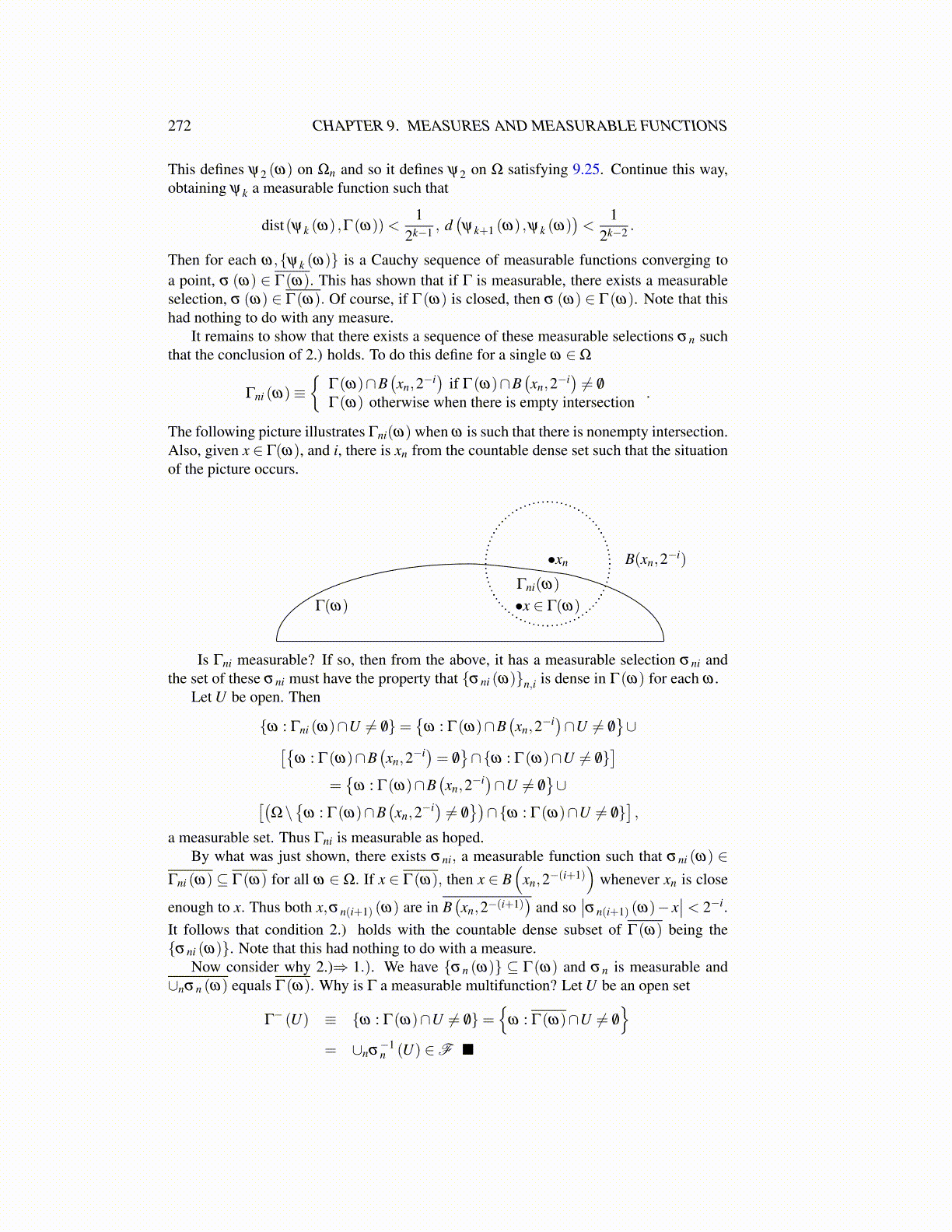
272 CHAPTER 9. MEASURES AND MEASURABLE FUNCTIONS
This defines ψ2 (ω) on Ωn and so it defines ψ2 on Ω satisfying 9.25. Continue this way,obtaining ψk a measurable function such that
dist(ψk (ω) ,Γ(ω))<1
2k−1 , d(ψk+1 (ω) ,ψk (ω)
)<
12k−2 .
Then for each ω,{ψk (ω)} is a Cauchy sequence of measurable functions converging toa point, σ (ω) ∈ Γ(ω). This has shown that if Γ is measurable, there exists a measurableselection, σ (ω) ∈ Γ(ω). Of course, if Γ(ω) is closed, then σ (ω) ∈ Γ(ω). Note that thishad nothing to do with any measure.
It remains to show that there exists a sequence of these measurable selections σn suchthat the conclusion of 2.) holds. To do this define for a single ω ∈Ω
Γni (ω)≡{
Γ(ω)∩B(xn,2−i
)if Γ(ω)∩B
(xn,2−i
)̸= /0
Γ(ω) otherwise when there is empty intersection .
The following picture illustrates Γni(ω) when ω is such that there is nonempty intersection.Also, given x ∈ Γ(ω), and i, there is xn from the countable dense set such that the situationof the picture occurs.
•xn
•x ∈ Γ(ω)Γ(ω)
Γni(ω)
B(xn,2−i)
Is Γni measurable? If so, then from the above, it has a measurable selection σni andthe set of these σni must have the property that {σni (ω)}n,i is dense in Γ(ω) for each ω .
Let U be open. Then
{ω : Γni (ω)∩U ̸= /0}={
ω : Γ(ω)∩B(xn,2−i)∩U ̸= /0
}∪[{
ω : Γ(ω)∩B(xn,2−i)= /0
}∩{ω : Γ(ω)∩U ̸= /0}
]={
ω : Γ(ω)∩B(xn,2−i)∩U ̸= /0
}∪[(
Ω\{
ω : Γ(ω)∩B(xn,2−i) ̸= /0
})∩{ω : Γ(ω)∩U ̸= /0}
],
a measurable set. Thus Γni is measurable as hoped.By what was just shown, there exists σni, a measurable function such that σni (ω) ∈
Γni (ω) ⊆ Γ(ω) for all ω ∈ Ω. If x ∈ Γ(ω), then x ∈ B(
xn,2−(i+1))
whenever xn is close
enough to x. Thus both x,σn(i+1) (ω) are in B(xn,2−(i+1)
)and so
∣∣σn(i+1) (ω)− x∣∣< 2−i.
It follows that condition 2.) holds with the countable dense subset of Γ(ω) being the{σni (ω)}. Note that this had nothing to do with a measure.
Now consider why 2.)⇒ 1.). We have {σn (ω)} ⊆ Γ(ω) and σn is measurable and∪nσn (ω) equals Γ(ω). Why is Γ a measurable multifunction? Let U be an open set
Γ− (U) ≡ {ω : Γ(ω)∩U ̸= /0}=
{ω : Γ(ω)∩U ̸= /0
}= ∪nσ
−1n (U) ∈F ■